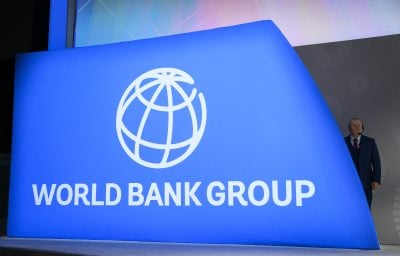While the rankings at the top end of the table continue to follow the general pattern, South African banks, reflecting a very sophisticated system, are still dominant but their lead is being whittled away by North African banks, and, perhaps surprisingly, by pan-African institutions such as Ecobank. Overall however, Africa’s banking sector has remained stagnant over the period of the ranking despite healthy economic growth generally. Nevertheless, a boom in cross-border trade seems to be on the way. Whether this will be the pattern over the next few years or not is still to be seen. This report has been compiled by associate editor, Neil Ford.
Some underestimate the importance of banking to wider economic growth; regarding it as just one sector in a well-balanced economy. Indeed, access to savings and credit is limited in most parts of Africa. According to figures from the annual assembly of the Association of African Central Banks (AACB), just 23% of Africans have access to any kind of formal banking services at any point in their lives. For too long, African banks focused on restricting their services to very large companies and high-net-worth individuals. With shiny marble branch entrances and well-dressed staff, many required a minimum deposit of $1,000 to open an account, thereby ignoring 90% of the populations within which they operated. They also require high guarantees from the small and medium-sized enterprises (SMEs) that comprise the bedrock of most successful economies. Banking services were irrelevant for most Africans.
This sad state of affairs is slowly but undoubtedly changing. Greater competition and slowly growing personal wealth are making banks aware that they can no longer restrict themselves to such narrow activities. At the same time, mobile banking has revealed that a large unbanked market already exists, as millions of people now use handsets to save, transfer money and pay bills. Yet continued strong economic growth demands that individuals and businesses have full access to the banking services that benefit their lives. Investment and the movement of people, goods and money are all aided by financial services. Despite the sector’s many failings, banking is not one sector in a vibrant economy: it is the foundation upon which most other sectors are built.
The top four banks in Africa are the same in our 2013 table as in last year’s survey. Top spot is retained by South Africa’s Standard Bank, with a rise in its Tier 1 Capital from $9.8bn to $10.3bn. However, its dominance is reinforced by a lack of growth in its closest rival. FirstRand remains in second place, despite a decline in capital from $8.4bn to $7.6bn. Absa and Nedbank make it a South African top four but the fifth-biggest South African bank, Investec South Africa, has fallen from fifth to eighth as a result of a drop in capital from $2.8bn to $2.6bn. It is overtaken by two Moroccan banks, Groupe Banque Populaire and Attijariwafa Bank, plus Nigeria’s Zenith Bank. South Africa still dominates but rivals continue to chip away at its position.
Two of the biggest risers over the past year are two entities of Ecobank. Ecobank Transnational (the group holdings) moves up four places to 12th, while Ecobank Nigeria rockets up from 45th to 22nd following their acquisition of Oceanic Bank in Nigeria. With a focus on cross-border trading, the company is well placed to prosper from growing trade volumes over the coming years. It operates in 34 African countries, more than any other bank, and has drawn up plans to launch in three more, suggesting that it could become the first bank to operate in every viable African state. However, there is no close correlation between the size of an economy and the number of banks operating within it. For instance, Kenya has 43 licensed banks, in comparison with just 20 in Nigeria. This could be indicative of less-intense competition in Nigeria, but the current crop of Nigerian banks are certainly a more attractive proposition than the plethora of poorly capitalised banks that operated in the country a decade ago. Nigerian banking is still on the rise.
Yet the past year has been rather a mixed one for African banks in general. The 100th ranked company in our table, Union Bancaire pour le Commerce et l’Industrie of Tunisia, just makes it into our table with Tier 1 Capital of $135m, a mere $1m more than First National Bank of Botswana needed to take the same spot last year. Similar indicators elsewhere in our table reflect a general stagnation in the industry. After the dramatic ups and downs of recent years, there is nothing intrinsically wrong with this. Yet during a period of relatively strong continental economic growth, rising levels of cross-border trade and an expanding market for bank services, this lack of growth in both capital and assets is a little unusual. While analysts like to divine momentous changes on relatively little evidence, it is perhaps too soon to make any firm conclusions. It will be interesting to see whether this is a statistical anomaly or something more substantial in our survey next year.
It is interesting to consider the geographical spread of banks across the continent. Of Africa’s Top 100 banks, 10 are based in Eastern Africa, down from 11 last year; and 19 in West Africa, up from 18 last year. North Africa is the best represented, with 42 banks this year, down from 44 last year; while Southern Africa, including Mauritius, has 28, up two from our 2012 survey. The most startling region, however, is Central Africa, which is the big black hole at the heart of the African banking map, with just a single entrant, BGFI of Gabon. Take note, governments of Central Africa.
The balance of power, however, is very different when we consider total capital and assets. With combined Tier 1 Capital of $34bn out of the continent’s total of $95bn, South Africa is still by far the most important banking centre in Africa, although its share is steadily falling year on year. Its lead is even more overwhelming when assessed in term of assets, with almost half of all combined banking assets on the continent. By Tier 1 Capital, the next most import banking markets are Nigeria, Morocco and Egypt in that order, with the rest much further behind. Algeria (if it could only reform its cash-awash financial sector) and Angola are the only countries that look likely to join this elite club in the medium term.
Cross-border investment
There is little doubt that after years of slow but steady investment, the African banking landscape is on the verge of a boom in cross-border investment. International banks, such as Standard Chartered and Barclays, have long operated across the continent. Yet the pool of significant players is greatly increasing, as South African banks move north, Moroccan banks look south and Nigeria’s consolidated firms begin to move out in all directions beyond their own borders.
Having expanded steadily within their own market, Mauritius’ home grown banks are now assessing attractive markets on the African mainland. Another company that was formed with pan-African aspirations from the very start, Ecobank Transnational, may be particularly well placed to make the most of this new scramble for banking customers. All this activity is driven by optimism over the economic future of the African continent and forecast strong, sustained economic growth in most countries.
Indeed, South Africa’s Standard Bank has gone as far as pulling out of emerging markets in other parts of the world in order to focus on its Africa’s operations. Standard Bank recorded a 23% rise in income from personal and business banking in its non-South African operations for the first half of this year; plus a 41% rise in deposits and a 29% increase in loans and advances from the region. These are all better figures than for its South African operations.
Diana Layfield, Standard Chartered’s chief executive for Africa, said: “It’s an incredibly exciting phase. What you have seen, particularly in some of the newer local regional banks, is an ability to serve emerging mass market consumers where other financial institutions haven’t necessarily been able to cover effectively.”
The short-term prospects for strong growth in South Africa itself are poor. In September, credit ratings agency Moody’s stated that the outlook for the South African banking sector was negative because of: the sluggish operating environment, which will weaken asset quality and increase provisioning needs; the banks’ sizable holdings of sovereign securities, linking bank credit profiles to that of the government of South Africa [which is rated Baa1 negative]; and funding challenges due to reliance on short-term wholesale deposits. It also forecast that the rate of non-performing loans will increase.
Moody’s noted “holdings of government securities and loans to state owned entities account for more than 150% of banks’ Tier 1 capital, on average. Therefore, any deterioration in South Africa’s credit profile would exert downward pressure on the credit profiles of the largest banks”.
However, it added “South African banks’ resilient core earnings and ample capital levels will limit to some extent the credit pressures noted above, providing an adequate absorption buffer for possible loan losses”.
South Africa’s banking sector prospects are just limited in comparison with those of other African states. Although Moody’s is more optimistic about the state of the US and UK banking sectors, the agency has given a ‘negative outlook’ to most other industrialised nations, including Germany and the Netherlands.
The region now contributes 36% of Standard’s total corporate and investment banking. However, the group head for personal and business banking in Africa, Peter Schlebusch, conceded that the firm had experienced problems with operations in Tanzania and Zambia, particularly with regard to local management. He said: “We have taken some corrective actions and we understand these markets much better now.”
The results of this expansionism are likely to be greater competition for both business and personal customers but it is vital that such cross-border investment is encouraged and that unnecessary barriers are removed. A more fully integrated banking industry could help drive African economic growth for years to come, while continued poor access to finance would continue to stymie development. Above all, it is important that governments and central banks use this opportunity to widen access to banking services. South Africans have an average of about one savings account each, although of course some people have none and others several. By contrast, only one Burundian in five has any type of account. Yet Kenya Commercial Bank managed to make profit in Burundi last year, in its first full year of trading in the country, suggesting that low penetration rates are not simply a matter of limited demand.
Some see mobile and online banking as separate sectors but the reality is that banking works best when it is integrated. The evidence to date is positive although mixed. Many banks are looking to integrate their operations across all branches and all platforms, from physical branches to mobile and internet access. As the experience of Kenya has shown, it could be mobile banking that holds the key to providing services to the bulk of the population.
Regulatory changes
Many bankers complain that regulations continue to restrict access to banking services. Douglas Munatsi, the group chief executive of BancABC, which is based in Botswana, told journalists: “The reality is that some regulators don’t apply the rules the same way, on issues such as the minimum capitalisation of a bank. Sometimes the process is not as transparent as it should be. A country may have very positive investment rules, but labour laws can be very rigid, such as those covering expatriates in Botswana.”
Growing intra-African trade means that companies need to be able to access the same services in all countries. Even in regional trade bodies, such as the Southern African Development Community (SADC) and the East African Community (EAC), the same international banking regulations are adopted in different ways by different countries. The situation is even worse for individuals. Those with homes in one country and workplaces in another – such as many mine workers – are often unable to pay wages into a bank at work to be accessed from their home countries. Many are forced to pay money transfer charges in order to access their own wages. In many cases, parallel technology is incompatible; in others, unnecessary rules and charges deter the movement of money. Yet ensuring the free flow of money is one of the foundations of any effective capitalist system.
The role of central banks is key, particularly as they often act as sector regulators. As the experience of Nigeria has shown, a proactive central bank can rescue failing banks, raise standards and simultaneously encourage both consolidation and greater competition, although they are only as effective as their governments allow them to be. Some are now being given a greater role in promoting economic stability. African central banks are pursuing the African Monetary Cooperation Programme in order to strength the continent-wide economy. Yet progress on implementing the programme’s various elements is proving difficult. Central bankers are already required to keep annual inflation at 5% and should soon reduce this target to 3%, yet many countries continue to struggle with double-digit growth.
Want to continue reading? Subscribe today.
You've read all your free articles for this month! Subscribe now to enjoy full access to our content.
Digital Monthly
£8.00 / month
Receive full unlimited access to our articles, opinions, podcasts and more.
Digital Yearly
£70.00 / year
Our best value offer - save £26 and gain access to all of our digital content for an entire year!
 Sign in with Google
Sign in with Google 


